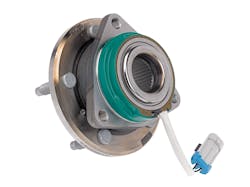Unitized hubs offer optimized automotive performance
Innovations in automotive aftermarket components have been on the rise in recent decades, as motorists and vehicle manufacturers are investing in digitally enhanced and revolutionized tools and devices to improve passenger safety and enhance car functionality. Among them are advancements in wheel end systems, such as preassembled, unitized hubs, as well as the integration of onboard electronic sensors to offer intelligent and highly dependable solutions that not only optimize overall drivability but are critical to your anti-lock braking system (ABS) and the traction control system (TCS).
According to a study from Research Reports World released in May 2021, the global automotive wheel hubs industry is forecasted to grow from its 2020 figure of $22.590 million to $29.580 million by 2027. To remain competitive within the industry, manufacturers must adapt to evolving aftermarket trends that will contribute to this predicted market progression by developing user-friendly, cost-effective, and efficient wheel-end systems that drive customer safety and convenience.
What is a unitized hub?
Simply put, a unitized hub, also known as a hub unit, is designed for quick and easy assembly. Each unit usually consists of a wheel hub bearing and flange as well as one or more of these components: axle nut, c-clip, an inner and outer ring, and seal. To support evolving automotive technology and original equipment manufacturer (OEM) trends, an increasing number of hub units also feature embedded sensors that communicate with the vehicle’s computerized program unit (CPU) to control functions such as ABS, TCS, and tire pressure management (TPM).
One of the many advantages of the hub unit is that most are sealed and lubricated for life. Most designs are also capable of handling heavy thrust and radial loads, which are the forces the bearings must endure when the vehicle is cornering or braking. Having all the components pre-set into one easy-to-use kit, eliminates the concern for procedural errors, makes the installation process much less time-consuming and decreases the number of tasks and out-of-pocket costs associated with having to purchase multiple different products.
General best practices
Over a period of time, it’s only natural that heavy usage can often wear out a car’s wheel hub units. As a result, ABS sensors can also break down, causing safety risks to the driver and passengers. Some early warning signs that can alert a driver when it’s time for a bearing replacement include any friction noise on wheel rotation or unusual slowness in the turning action of the suspended wheel assembly.
The good news is there are proactive steps that a vehicle owner can take to prevent premature hub unit failure. A few general best practices to ensure you get the most out of your investment are outlined below. As always, be sure to follow the manufacturer’s recommendations for proper wheel end assembly care, torque specifications and installation.
Make sure to use the right type of tools for installation; for instance, do not use an impact gun to torque the axle nut, as it could damage the ball bearings and races of the hub.
Check the alignment of the hub unit to determine if the component is bent.
Do not try to set clearances on hub units; they are set at the factory by the manufacturer with the correct preload and torque specifications.
Inspect the wheel bearings for damage, including the spindle assembly, axle joints, wheel flanges and the vehicle frame, during any brake replacement work (regardless of the age of the vehicle).
Never take a hub unit apart before mounting; the raceways and seals will be damaged and the bearings destroyed, causing the unit to fail prematurely.
Do not try to move or adjust the seal on a hub unit. The seal will be destroyed, and water penetration will occur, leading to corrosion.
If replacement is needed, be sure to replace the hubs or bearings on both wheels, as both wheels have the same mileage and were subjected to the same wear and tear from heavy usage and road conditions.
Most manufacturers recommend lubrication at 24,000 miles for the front wheel bearings on rear-wheel-drive vehicles.
The SKF hub unit evolution
SKF has led the way in wheel-end innovation since the invention of the automobile, pioneering the concept of the pre-assembled, unitized hub. To put the evolution of the design of SKF hub bearing units into better perspective, let’s take a deeper dive into the company’s portfolio of solutions:
Hub Bearing Unit 1 (HBU1):
Based on a double row angular contact ball bearing, the SKF Hub Bearing Unit 1 (HBU1) is optimized for the special operating characteristics encountered on car wheel applications. The unit offers specific support the moment a load is applied to the bearing during cornering. The main components, an outer ring and two inner rings, are matched with the ball set to give the correct clearance. The cages for the two ball rows are made from glass fiber reinforced polyamide. HBU1 is greased and sealed for life. Used mainly for driven wheels, HBU1 is also found in integral drum designs on the non-driven wheels of smaller cars.
Hub Bearing Unit 2 (HBU2):
Designed with the experience gained with HBU1, HBU2 has an outer ring with an integral flange, replacing the function of a separate hub. The flanged outer ring is designed as a lightweight structural component and the outer ring raceways are induction hardened for optimal bearing performance. The flange is tough, with threaded holes or studs and a spigot to center and mount the brake and wheel. The dimensions of the flange and spigot are designed to customer requirements. HBU2 is typically used with a rotating outer ring for non-driven front or rear wheels.
Hub Bearing Unit 3 (HBU3):
The third-generation hub bearing units carry a flange for the wheel and brake rotor attachment and a second flange for fixing the unit to the suspension. This fully integrated system provides significant simplification in corner design and handling when compared with more traditional designs. The dynamic load carrying capacity is maximized by using a separate inner ring for the inboard ball row. This inner ring is mounted with an interference fit and the outer ring flange is bolted to the suspension. The rotating inner ring, with its tough flange, spigot and threaded holes or studs, is designed for mounting the brake and wheel. HBU3 is also greased and sealed for life and used for both driven and non-driven wheel applications.
Setting the world’s standard for aftermarket wheel end component quality, SKF Vehicle Aftermarket introduced “smart” hub units with built-in electronic sensors – including those commonly used with today’s ABS, traction control and navigation systems – for added safety, improved performance, efficiency, and reliability.
Automotive manufacturers are under relentless pressure to improve the performance of their vehicles. Integrated wheel-end assemblies provide an all-in-one, easy-to-install solution that delivers a plethora of benefits, including enhanced driver safety, better steering and handling, performance longevity, and a lower overall total cost of ownership (TCO).
About the Author

David Massanga
David Massanga is a global training manager (international trainer) at SKF. He has a Master of Business Administration degree and was recently recognized for being a part of the TMC Class of 2022 Leaders of Tomorrow.
